Once upon a time, every groundbreaking tech project was an idea waiting to be transformed into reality. Yet, the majority of software projects didn’t survive the journey from conception to market launch — while some of the ideas grew into successful ventures, many others faltered along the way. So, is there a strategy that increases the project’s chances of success?
Following a proven software product development process coupled with strategic marketing initiatives could be half the battle in this case. In this article, we will focus on the technical side of the issue and explain what a structured approach to software product development looks like.
Software Product Development Process vs Software Development Lifecycle
Often mixed up with the software product development process, the software development lifecycle refers to the series of stages or phases that a software product goes through from inception to retirement. It represents the progression of the software product through different states over time. The lifecycle provides a high-level view of the evolution of the software product from concept to end-of-life, just like in our decade-long partnership with Mogami, where we developed three distinct iterations of the personal finance applications, employing progressively advanced technology stacks.
The software product development process, in turn, refers to the overall series of activities and steps involved in conceiving, designing, building, testing, deploying, and maintaining a software product.

Olexandr Boyko
Delivery Director at SPD Technology
“The difference is that the software product development lifecycle can last for years, and it is much more than just the implementation of a specific software development project. Common stages in the software development lifecycle include planning, analysis, design, implementation, manual and automated testing, deployment, and maintenance.”
In addition, there is one more concept you should know and distinguish it from the product development process and lifecycle – software development methodology. It refers to the specific approach, set of practices, principles, and guidelines used to execute the software product development process, providing a structured framework for organizing and managing the development activities.
Both a well-planned software product development process and a well-suited product development methodology are very important to the success of your project. We will describe both and share some valuable insights that are based on SPD Technology’s experience.
Advantages of Having a Clear Software Product Development Process
A structured software development process promises significant benefits that become a foundation for an outstanding product. This section will focus on some of the most important ones.
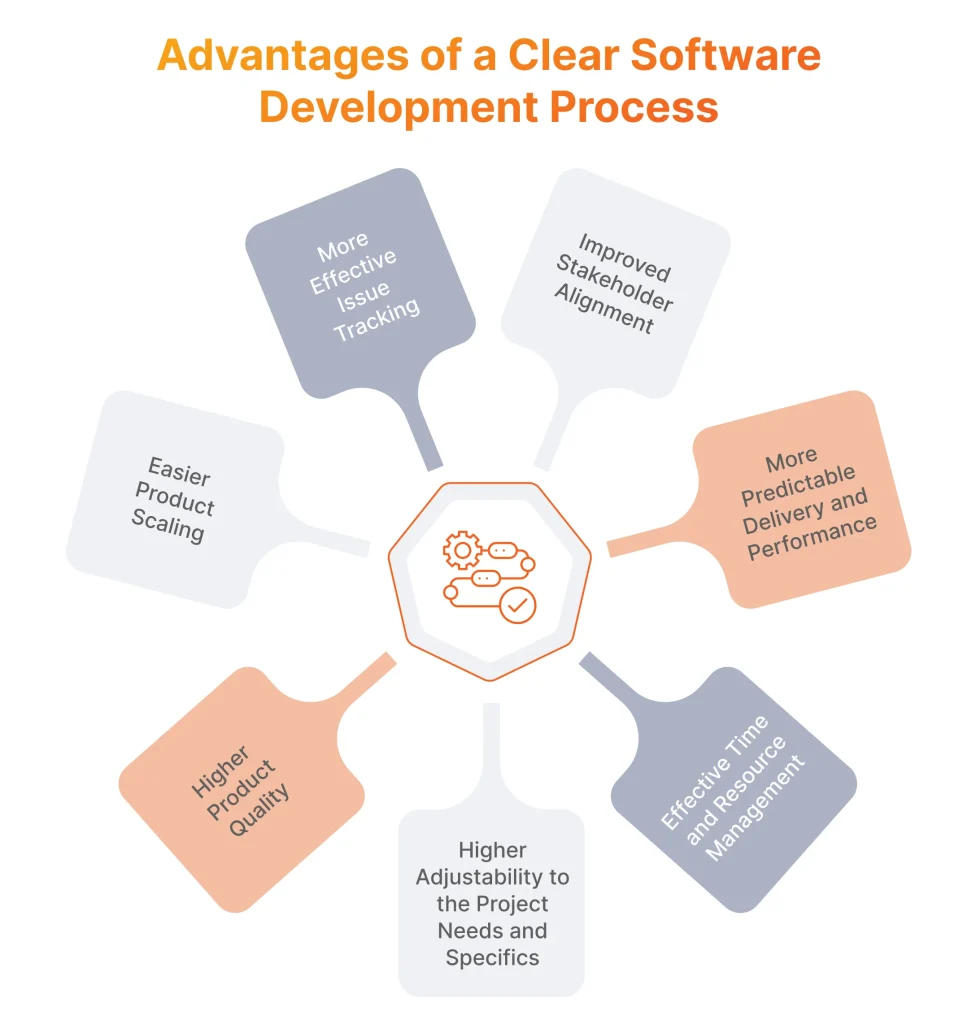
Improved Stakeholder Alignment
With a well-defined process for new product development, we can talk about an exceptional level of transparency, synchronizing visions of stakeholders, developers, product owners, and end users. In terms of goals, deadlines, and results, they will all have the same perspective on the process. This alignment elevates collaborations and lowers any misunderstandings.
More Predictable Delivery and Performance
Having a clear development process allows for delivering the project as planned and approved with stakeholders. Setting clear tasks and milestones also enable the team to stay on track, following a project vision and avoiding burnouts as a result of work overload.
Effective Time and Resource Management
The structured process also allows for more effective resource allocation, helping to detect bottlenecks in the early stages and rapidly implement the necessary changes. It ensures that every team member knows their current task which is aligned with the overall project development strategy, minimizing time waste, and keeping the project on schedule.
Higher Adjustability to the Project Needs and Specifics
Another prominent advantage of a process with clear software product development steps is having a flexible framework that allows the project to adapt to changing market conditions, allocated budgets, development trends, or unseen circumstances. Processes like Agile or Kanban help teams focus on high-impact tasks first, avoiding wasted effort on less critical activities.
Higher Product Quality
When the product design & development process is well-defined and predictable, it involves timely execution of testing, validation, and conducting regular feedback loops. That’s why it should be reasonable to expect an end product with better performance, fewer bugs, and outstanding standards of quality, delivering optimal value for its customers.
Easier Product Scaling
Knowing what exactly is happening during the software development process, with specific timelines, tech stacks, and scope of work for each phase, unlocks the potential for scalability, from the changes in early development stages to making future adjustments much smoother and cost-effective.
More Effective Issue Tracking
Finally, potential issues can be identified and addressed as fast as possible, and, in some cases, even prevented. It is possible to incorporate highly effective tracking mechanisms when they are required to ensure the smoothest workflows and the top integrity of the product across the board.
Software Product Development Process in 9 Steps
Now, after the essence of the software development lifecycle and process become clear, let’s review the essential stages in the life of any software development product, with a brief description of each one.
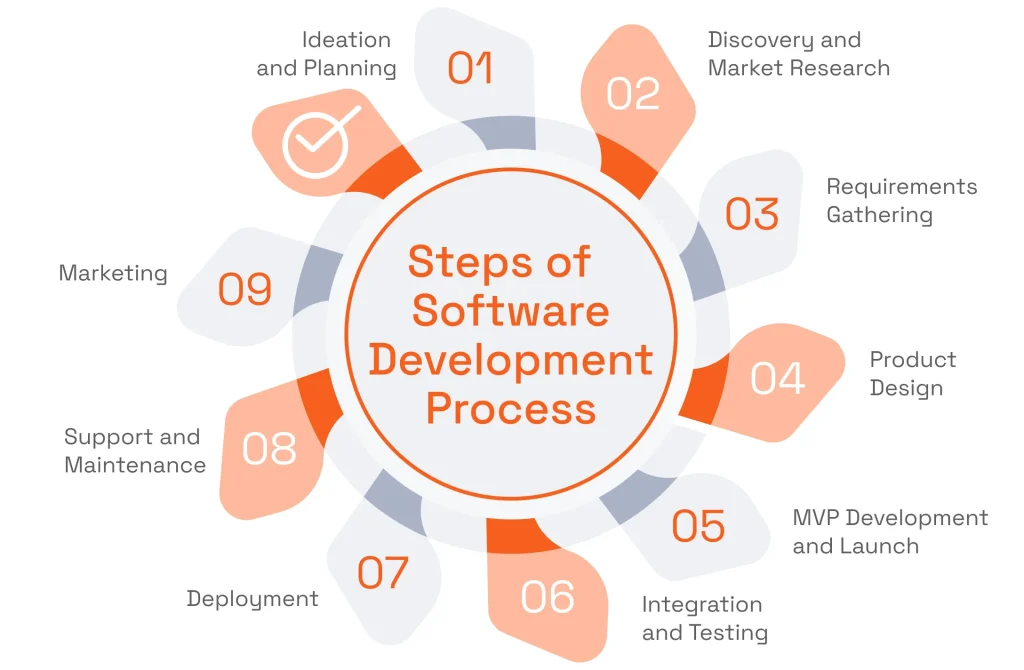
Ideation and Planning
At the heart of every innovation lies an idea — yet, the true measure of its potential lies in its quality and viability. So, the new product development process starts with assessing the strength of your idea. But how to do it? What can you do to improve it?
The answer to these questions is brainstorming that is the first of many stages of product development. Traditional brainstorming sessions involve gathering a diverse group of stakeholders and encouraging them to freely share ideas, thoughts, and suggestions related to the project.
In addition to brainstorming, at this stage, you are welcome to use mind mapping. This technique stands for visually organizing ideas and concepts in a hierarchical structure, starting with a central theme or topic and branching out into subtopics and related ideas. Also, don’t skip the SWOT Analysis that allows for identifying the internal strengths and weaknesses of the project, as well as external opportunities and threats in the market.
Discovery and Market Research
The next step is to find out whether your product-to-be is what the market currently needs. Find out the market demand for the kind of products you intend to build, and do the research into your potential customers’ needs.
It will also be a good idea to brainstorm with your team and try to jointly answer the following questions:
- What problem does my product solve, and is it a significant pain point for our target audience?
- Who are our target customers, and what are their demographics, preferences, and behaviors?
- How does our project differentiate itself from existing solutions or competitors in the market?
- Have we conducted market research and validation to assess the demand for our product or service?
- What is our unique value proposition, and how compelling is it to potential customers?
- What are the key features and functionalities of our product or service, and how do they align with the needs of our target audience?
- How scalable is our idea, and what are the potential growth opportunities in the market?
- What are the potential risks and challenges associated with our startup, and how do we plan to mitigate them?
- What is our revenue model, and how do we plan to monetize our product or service?
- What resources, including team members, technology, and funding, do we need to bring our startup idea to life?
- Can we somehow benefit from the current trends and predict the future ones?
Gathering Requirements and Conducting Feasibility Analysis
When the market research is complete, it is time to figure out how to build your product from the software development perspective. Your development team must understand the project goals and determine how feasible they are to implement.
Typically, the following requirements should be gathered:
- Functional Requirements: specifying what the system should do, and defining the system’s behavior in terms of inputs, outputs, processes, and data.
- Non-Functional Requirements: defining the system’s characteristics or qualities, like performance and scalability. To get a better idea of what these two groups of requirements represent and how to gather them, you are welcome to check our article on requirements for document management system.
- User Requirements: describing what the users expect from the system, including roles and permissions, user interfaces, and customization options.
- System Requirements: specifying the hardware, software, and infrastructure needed to support the system.
- Business Requirements: capturing the business objectives driving the project.
- Constraints: defining limitations or restrictions on the system’s design and implementation.
- Quality Attributes: specifying the desired software quality levels for various aspects of the system.
- Documentation and Training Requirements: defining the need for user manuals, technical documentation, and training materials.
- Testing Requirements: specifying the types of testing needed to ensure the system meets its requirements.
- Change Control and Versioning: defining how changes to requirements will be managed and tracked throughout the project lifecycle.
- Acceptance Criteria: specifying the conditions that must be met for the stakeholders to accept the system.
- Dependencies: identifying any external factors or dependencies that may impact the project’s execution or delivery.
- Risk Assessment: determining potential risks to the project’s success and strategies for mitigating them.
Product Design
This is the phase during which the whole of your software product’s design is created, including the definition of the workflows, standards for the project, tech stack, and functional capabilities. The creation of the final prototype takes place during this phase too.
The stages of product design typically include:
- Requirement analysis: gathering and analyzing requirements from stakeholders, understanding user needs, and defining the scope of the project.
- Market research and feasibility study: conducting market research to understand the competitive landscape, target audience, and feasibility of the product.
- Conceptualization and ideation: brainstorming and conceptualizing ideas based on the gathered requirements and market research.
- Prototyping and design: creating prototypes, wireframes, and mockups to visualize the product’s user interface and user experience.
- UI/UX design: creating visual designs, defining navigation flows, and ensuring usability and accessibility.
- Architecture design: designing the software architecture, including system components, modules, and their interactions.
- Technical design: designing database schemas, APIs, and integration points with external systems.
- Review and validation of stakeholders: ensuring alignment with requirements and expectations, as well as resolving design issues early.
- Creating documentation: documenting the design decisions, specifications, and guidelines for developers, testers, and participants.
- Design refinement: revisiting earlier stages of the design process to incorporate new information or address evolving needs.
- Finalization and the handoff to development: ensuring that all design decisions are well-documented and communicated effectively to the development team.
These stages of the software product design process may vary depending on the specific methodology or approach followed in the software development process, and there may be overlaps between stages to accommodate changes and feedback throughout the product design process.
MVP Development and Launch
The next step in the software product design and development process is building the Minimum Viable Product (MVP), the most basic version of a product that can be released to the market while still providing value to users. It typically includes only essential features and functionalities necessary to address the core problem or need of the target audience. It is important to launch your MVP according to the LEAN development approach, a methodology that focuses on maximizing value delivery to customers while minimizing waste and optimizing resources.
Here are some tips to consider while developing an MVP:
- Even though the MVP is minimal, it should still provide a positive user experience, prioritizing usability, simplicity, and intuitive design to ensure that users can easily understand and interact with the product.
- While focusing on simplicity, ensure that your MVP is built on a scalable architecture that can accommodate future growth and feature enhancements.
- Establish feedback loops with users, stakeholders, and development teams throughout the development process.
- Define key metrics and performance indicators that align with your product goals and objectives.
- Anticipate that your MVP will evolve based on user feedback, market validation, and changing requirements.
Integration and Testing
The approaches to system testing and integration may vary, but this phase of tech product development process typically involves Quality Assurance experts using multiple frameworks and continuous integration for high-quality testing. Both manual and automated testing make sense for the majority of software development projects. Only when the software is considered bug-free, can we move on to the next step.
Below are some suggestions to make the testing process the most effective:
- Start testing early to identify and address issues sooner, reducing the cost and effort of fixing them later in the process.
- Define clear test objectives and goals to understand what you’re trying to achieve with your tests, whether it’s validating functionality, assessing performance, or ensuring security.
- Utilize test automation tools and frameworks to automate repetitive and time-consuming testing tasks.
- Prioritize testing activities based on risk, impact, and criticality of features.
- Employ a mix of testing techniques, including functional testing, regression testing, performance testing, security testing, usability testing, and exploratory testing.
- Implement Continuous Integration (CI) and continuous testing practices to automatically build, test, and deploy changes to the software.
Deployment
At this stage, your software project moves into production. In the future, changes and further improvements will be delivered, but the core product is ready for the end-users. Simple projects can be launched in a single release, and more complex ones require a staggered release.
Best practices for the deployment process include:
- Automation of deployment processes wherever possible, leveraging tools like Jenkins, Travis CI, or GitLab CI/CD.
- Adoption of infrastructure as code practices using tools like Terraform or AWS CloudFormation.
- Deploying changes in small, incremental batches rather than large, monolithic releases.
- Monitoring the health and performance of deployments in real-time using monitoring tools like Prometheus, Grafana, or Datadog to track key metrics such as response times, error rates, and resource utilization.
Maintenance and Post-Release Support
After receiving enough real-world user feedback, your development team can focus on making adjustments that will improve the product’s performance. Maintenance and regular updates will help you cover any additional needs of your users.
The activities in this process include, but are not limited to:
- Bug fixing
- Enhancements and updates
- Identifying and addressing security vulnerabilities
- Performance optimization
- Configuration management
- Data management
- Documentation updates
- User support and training
- Monitoring and alerting on any anomalies
- Feedback collection and analysis
- Release management.
Marketing
Last but not least, marketing activities must be agreed with a software product development company to begin together with the development process. Even if you don’t have a complete product, it makes sense to start the preparations and promote it as much as you can to ensure the success of the whole project.
We already mentioned marked research that happens before the start of the development process. During the development process, you may focus on building and optimizing a user-friendly, informative, and engaging website to showcase the software product. You should optimize your website and landing pages for search engines, and make sure that you leverage relevant keywords, meta tags, and descriptive titles to attract organic traffic.
Every business scenario is unique, so you should work on specific actions and strategies with your marketing team. Those actions may include:
- Building and nurturing an email list of prospects, leads, and potential customers.
- Collaborating with influencers, experts, bloggers, and thought leaders to amplify your marketing efforts.
- Offering free trials or demos after the release of the product
- Monitoring metrics such as website traffic, conversion rates, lead generation, customer acquisition cost (CAC), and return on investment (ROI) to improve your strategy.
Time-Tested Product Development Methodologies to Choose From
While the software development process defines a structured framework for what we should do step-by-step to build a tech solution, a software product development methodology, in turn, defines how we will do that. Numerous existing software product development methodologies can help you deal with projects of different levels of complexity, but which one would work best for you? To make the right choice, you have to analyze the next factors:
- Project requirements stability
- Customer involvement and feedback
- Project complexity, size, and business goals
- Time-to-market requirements
- Risk tolerance
- Dedicated development team experience and expertise
- Organizational culture and processes
Now, let’s dwell on the five most common software development methodologies, highlighting their advantages and disadvantages to help you decide.
Waterfall
Also known as a linear sequential model or a classic software development lifecycle model, Waterfall is one of the oldest and most popular software development models. It is based on the project team consecutively following each step of the entire software development lifecycle. In the real world, there is a slight overlap between the steps — you receive customer feedback during the process of building a new software product and revert to the previous step to make the required changes.
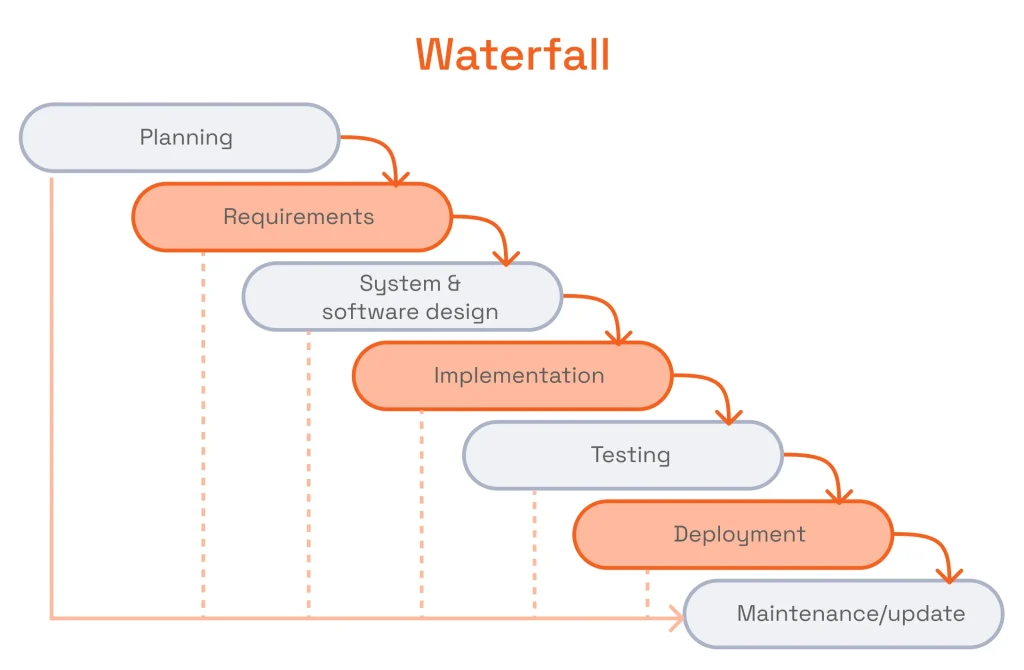
The name “Waterfall” describes a plan-driven software product development process with a strict order, where the phases are cascaded to each other and flow downwards like an actual waterfall.
Waterfall is great for projects with:
- Clear and stable requirements
- Predictable and repeatable processes
- Fixed budget and schedule
- Legacy Systems and Maintenance Projects
However, if you are introducing a new product and want to have the freedom to change the direction of the project after receiving user feedback, Waterfall may not be the right approach to product development lifecycle or process for your case. This software product development process is logical and transparent. However, it has one main disadvantage — a lack of flexibility. For this reason, projects eager to stay flexible and adaptable to rapid changes choose the next software development methodology.
Agile and Scrum
Agile methodology is a set of principles that you need to follow to build an effective new software product development strategy. If McKinsey is to be believed, the benefits of Agile methodology are undeniable. Compared to companies that don’t use Agile, 93% of organizations that do use it reported better customer satisfaction, 76% reported better employee engagement, and 93% reported better operational performance.
Scrum is the most popular practical embodiment of this software development methodology, used by 81% of Agile development teams according to the report by Digital.AI. In other words, Scrum is a real-world framework or a set of tools and instructions that are based on high-level Agile principles. The Agile/Scrum combination can be considered a separate software development methodology worth a more detailed explanation.
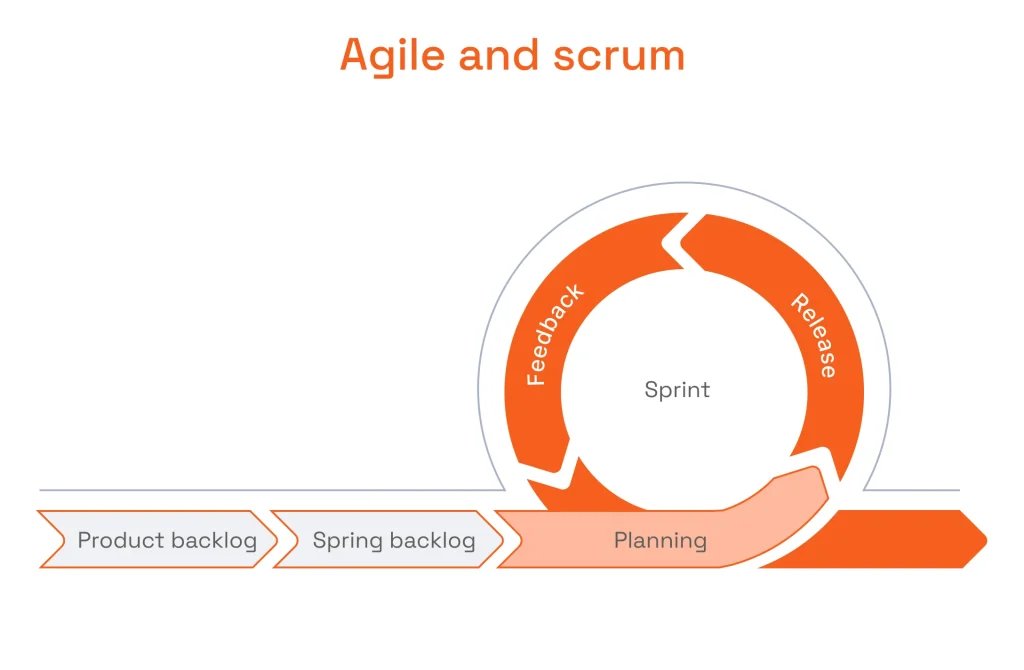
While the Waterfall software product development process has its strict flow, in Agile methodology, teams work in “sprints”. These sprints can last anywhere between two weeks and two months. At each sprint, the development team must deliver a usable software product with a view to receiving feedback on the improvements that need to be made.

Olexandr Boyko
Delivery Director at SPD Technology
“The Agile methodology is great when you need to quickly respond to the needs of your users and change the direction of your project, sometimes by making radical changes to your plans. You don’t need a complete list of the requirements or a statement of work before you begin the journey. Just choose a direction to move forward and keep in mind that when you decide to make a change, it won’t damage anything.”
Agile is great for projects with:
- Dynamic or evolving requirements
- Cross-functional teams
- Time-to-market pressure
- Complexity and high risk
Here is a quick example. Suppose you want to build a product with multiple features. With the Agile approach, it will take a sprint of 2-4 weeks to build a functional product with one single feature, but this product will be usable and ready for user evaluation.
The Agile product development process is the best fit for distributed software development teams that expect changes and continuous updates along the way. This means that startups and companies that are testing new products will benefit from this model the most.
On the other hand, if you are tight on budget and time, or you know precisely what you want to do, Agile may not suit your product development workflow that well. Because of the approach’s dynamic nature, following Agile can easily lead to the initial budget being exceeded or conflicts being created in the existing software architecture.
For example, we delivered a project for Legal Shelf, a LegalTech company, using Agile and Scrum methodologies. Within five months, we developed an AI/ML-enhanced web platform from scratch. This platform provides advanced document search and automated processing for 30,000 documents, resulting in a 40% increase in Legal Shelf’s customer base.
Incremental and Iterative
These methodologies combine the predictability of Waterfall and the flexibility of Agile. The Incremental and Iterative development processes are similar in their focus on small parts of the functionality. The difference between them lies in the actual release deliverables.
In the Incremental software product development process, you add one feature or function at a time. You can think of it as building a working Minimal Viable Product with basic functions and adding new features later.
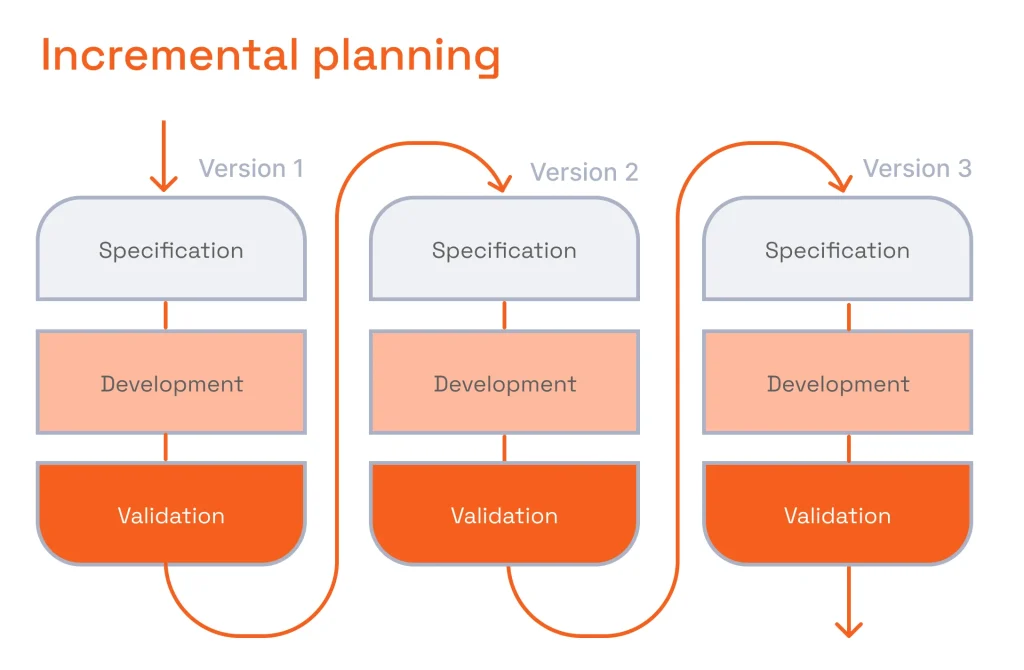
The Iterative process is different in that you must have all the planned features in the initial release – at least the most basic versions of them.
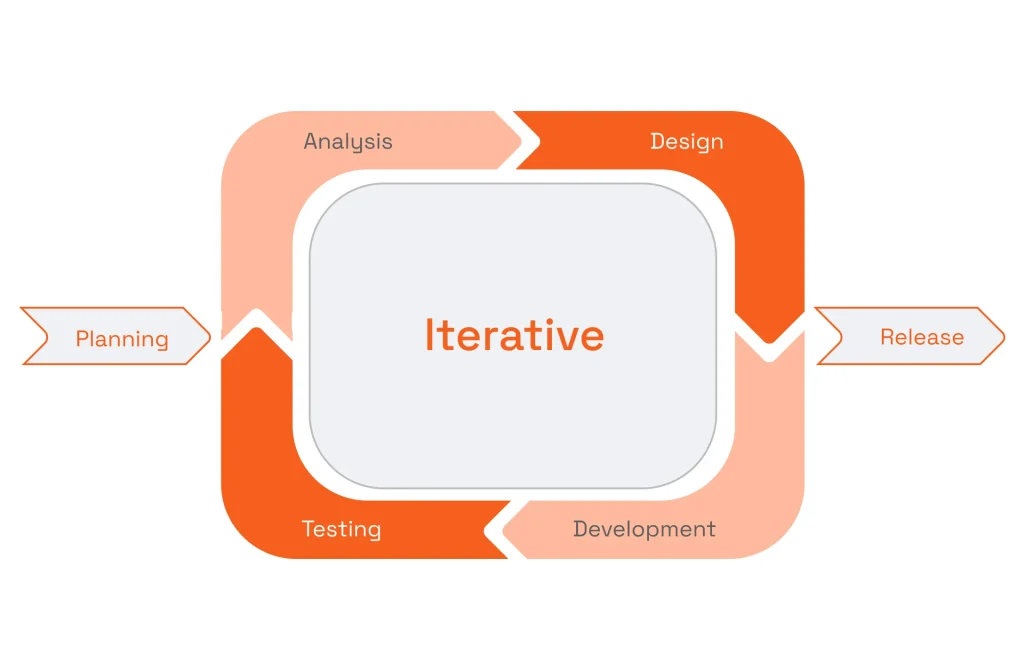
Product development phases introduced by the Incremental and Iterative process will allow you some flexibility, while also helping you keep everything going by the global plan. You may consider them for large projects with well-defined scopes, but choose something else if you don’t have a clear long-term technology plan.
How are Incremental and Iterative different from Agile?
- In Incremental, you build a complete feature for each sprint
- In Iterative, you build a version of a feature for each sprint
- In Agile, you do both— you add new features one at a time and improve the versions of the existing features with each next sprint.
V-Shaped
This software product development process is an improvement upon Waterfall and makes up for the latter’s biggest disadvantage: an insufficient amount of system testing. The V-Shaped process has a mandatory validation and verification step after each stage of the development effort.
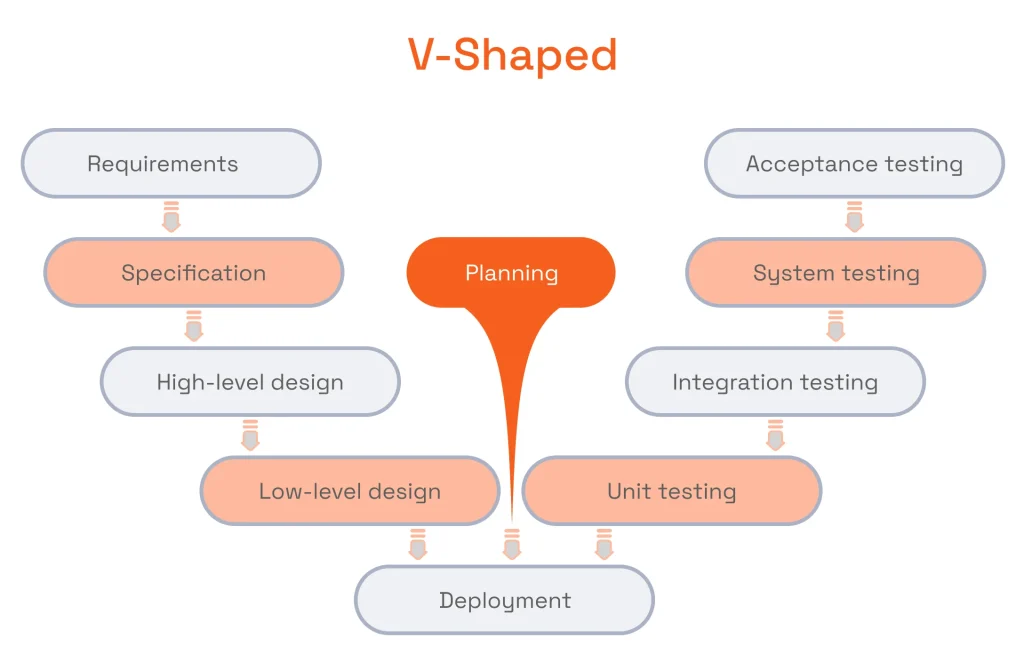
The V-Shaped approach works for relatively small projects with requirements and scope that won’t change later. Compared with Waterfall, where there is a risk of discovering critical issues at the very end of the software product development process, with V-shaped methodology, you have an opportunity to be aware of any blockers early on.
If you have a large-scale project, need flexibility, and expect to be making changes based on user feedback, V-Shaped may not be the best development approach option.
Spiral
The last software product design methodology we will talk about combines the flexibility of Agile, Iterative, and Incremental with the testing-driven nature of V-Shaped.
With each milestone, the scope of the project expands and risk analysis and planning become necessary again to prevent any possible failures during the software product implementation process.
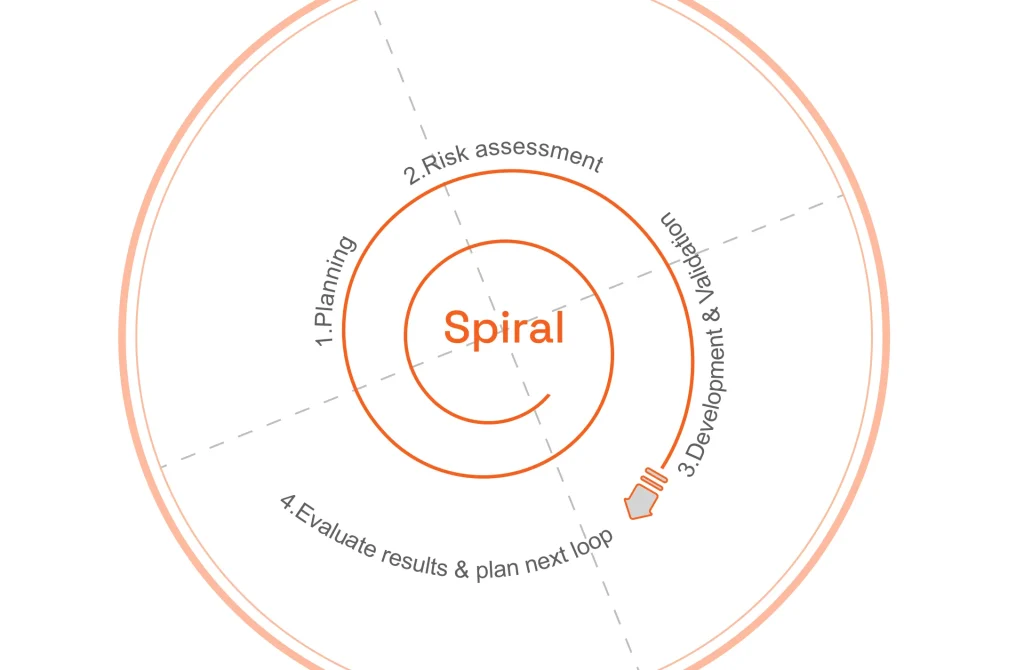
The main goal here is to mitigate the risks. If you have a big budget and work on a big project with a significant amount of documentation that requires validation, you can consider this approach. However, Spiral is rarely used because of the time and costs required to implement it. Instead, it is often referred to as an example of critical thinking in the Iterative approach.
Regardless of the software development methodology your project requires, we have the necessary expertise to handle it. In our latest article, we explained how to build an enterprise-level mobile application — feel free to discover the development strategy right now!
Challenges That May Affect Your Software Product Development Process
It is impossible to build a new product and avoid 100% mistakes, as they give you the experience to end up with a better result. Here is a short list of the challenges that you may encounter during different stages of software product development, along with the solutions to them.
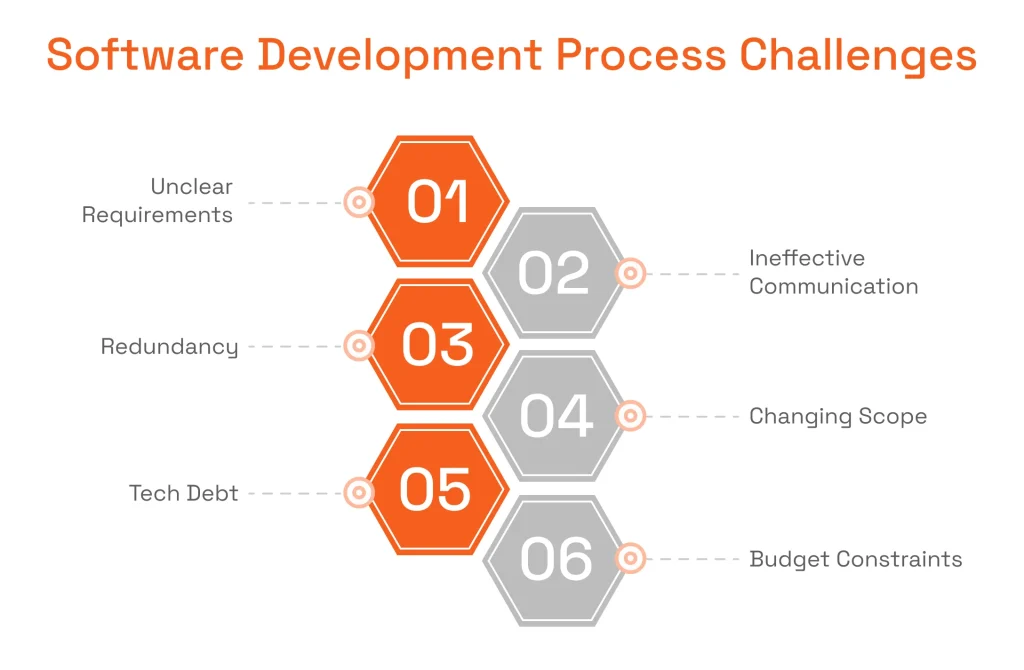
Unclear Requirements
Unclear requirements pose a significant challenge to the effective software development process, as they make it difficult to define the scope and objectives of a project. When requirements are vague or ambiguous, it ultimately leads to misunderstandings and project delivery delays, as well as an increased likelihood of rework and wasted resources.
Maintaining clear, up-to-date records of each requirement in a software product development plan is crucial. We, at SPD Technology, leverage the document management benefits to improve transparency, traceability, and collaboration, ensuring that any ambiguity in project scope is minimized early on. We also mitigate unclear requirements through continuous and structured communication with stakeholders, which includes regular meetings, and workshops, refining requirements, and aligning them with the project’s goals. In most of our projects, we leverage Agile methodologies, incorporating iterative feedback loops and early validation of requirements through prototypes and MVPs. Our team also uses collaborative tools to ensure transparency in documenting and sharing the requirements.
Ineffective Communication
In addition to unclear requirements, poor communication among team members, stakeholders, or departments can lead to misunderstandings, delays, and conflicts, increasing the risk of errors and duplicated work, as well as harming the morale of the team.
We ensure effective communication during all phases of product development by establishing clear and accessible channels for dialogue. In our projects, we conduct regular stand-ups, sprint reviews, and progress updates to keep everyone informed and aligned. We secure real-time updates by using tools like Slack, Jira, and Confluence, as well as any other that our client might want. This is one of the many reasons why our 120+ clients choose us for the offshore software development of their projects.
Redundancy
Redundant or duplicate efforts, code, or features can lead to inefficiencies, complexity, and increased maintenance overhead. Eliminating redundancy, in turn, helps streamline development, reduce costs, improve performance, and maintain code quality. For this goal, conduct code reviews, refactor codebase to remove duplicate logic, establish coding standards and best practices, promote code reuse, and leverage modular design principles.
We deal with redundancy in product development cycles by conducting regular code reviews and adhering to the highest coding standards. Our developers also leverage modular design principles and well-documented libraries to fully benefit from code reuse. In the early stages of the development, we also use automated tools and remove any duplicated logic.
Changing Scope
Changing scope is a common software development challenge that can occur due to various reasons, for example, shifts in business priorities, new stakeholder requirements, or emerging market trends. It can lead to budget overruns, timeline delays, disruption of development workflows, and potentially compromised product quality.
At SPD Technology, we manage scope changes with methodology-specific strategies. In Agile projects, we conduct regular sprint reviews and retrospectives, incorporating flexible and iterative changes. While we are prioritizing Agile for our projects, some projects require the Waterfall approach, so when using Waterfall, we develop contingency plans and conduct detailed impact analyses before implementing any changes. Additionally, our project managers communicate with stakeholders regularly to preventively adjust the development process following the planned scope changes.
Tech Debt
The consequences of taking shortcuts in software development to achieve faster delivery or meet immediate goals are known as tech debt, and it can massively degrade a system’s performance, scalability, and maintainability, increasing long-term risks and costs.
Our team proactively manages technical debt by conducting regular assessments of the codebase and infrastructure for our clients, using both automated tools and manual reviews to identify areas of concern. In most cases, we take an incremental approach to dealing with debt, breaking down large refactoring tasks into manageable pieces.
Budget Constraints
Limited budget or resources can constrain the scope, quality, or timeline of software development projects, failing to meet the expectations of stakeholders.
We ensure that these unfortunate consequences will not occur by always delivering on precise planning and Agile budgeting practices. We work in close collaboration with our clients to create realistic and detailed cost estimates for each phase of the project, including all possible expenses like infrastructure, tools, labor, and the usage of third-party services. Furthermore, we allocate budget resources incrementally based on the evolving needs of the project and adjust funding allocations as necessary during regular planning cycles.
Why Hiring a Tech Company with Established Development Processes Is Essential
Teaming up with product development companies that have well-defined development processes is vital to the success of software development projects in any industry and of any size. Professional tech vendors help establish a transparent process that offers clear milestones and precise progress tracking and keeps the stakeholders aligned and deeply informed during the entire duration of the development process. They also help implement rigorous planning, professional testing, and strict validation to avoid costly mistakes.
Additionally, having a solid development process and framework brings in the flexibility to adapt to changing needs, allowing the project to evolve in line with dynamic business goals and rising market demands. Even in an offshore software development model, partnering with a vendor that has well-defined processes ensures on-time delivery, transparent reporting, and consistent quality, regardless of location or time zone.
Finally, with a professional developer, you can be confident in the quality, scalability, and reliability of the final product, as these vendors have proven processes with the development processes tested in real-life scenarios.
Why Does Hiring SPD Technology Make Sense?
We pride ourselves as long-term partners, an essential part of the businesses of our clients, as opposed to just service providers. Our company has a well-defined and established software development process, that helps effectively deliver projects from an idea to market success, as we provide post-launch support, upgrades, and optimizations.
Our structured process includes thorough risk assessment and contingency planning from the very beginning, as we prioritize transparency and provide our clients with regular updates, detailed progress reports, and clear documentation at every phase. What’s more, our team engages in thorough SLA development, mapping out service-level objectives and performance metrics. This structured approach ensures stakeholders know exactly what to expect in terms of response times, maintenance commitments, and overall quality.
The clients of our company are fully involved and informed in the details of their respective projects, as we provide highly efficient communication processes as well, building trust and effective collaboration.
Our Expertise in Implementing an Effective Product Development Process
For over 18 years, SPD Technology has continued to be a trusted software product development company for companies around the world, building advanced tech solutions for businesses from multiple industries.
We know how to outsource web and mobile app development and have real-world cases to prove it. Recently, our client—a leading provider of prepaid and payment products with 3500+ employees — was acquired by a bigger company. The new owners evaluated the management level, delivery, and internal processes of our client. After this, they decided to shift to Agile. This was done to completely replace our client’s sometimes inefficient Waterfall process with Agile and Scrum.
Our partnership with this client spans over 8 years, during which we delivered great results in an adaptive development approach inspired by the best practices of SCRUM and XP. The clients hired a dedicated software development team with experts from different locations. The project management specifics of this case is that developers were working on the project from different time zones, so we had to constantly stay on the same page and coordinate the development efforts between US-based and Ukraine-based software engineers. As one of the most notable improvements in the internal processes of our client, we managed to deliver a Merchant Portal that facilitated the aggregation of over 8000 businesses within the United States in just two years.
In another prominent project, we helped a leading financial data and software company with the development of a sophisticated software platform designed to provide in-depth insights into the private and public capital markets.
In addition to the flawless execution of the software development process, this project is also highlighted by the delivery of our AI/ML development services. We built AI-powered features for growing market spotting and market trend detection, leading to a significant improvement in the company’s customer satisfaction. Additionally, AI-based automation helped to cut the manual data processing efforts in half.
Conclusion
The software product development process requires careful planning, collaboration, and adaptability to succeed in today’s dynamic and competitive market. Traditional methodologies such as Waterfall prioritize sequential phases of development, with requirements gathering, design, implementation, testing, and deployment occurring linearly. While this approach provides structure and predictability, it can be rigid and inflexible in the face of changing requirements or market conditions.
In contrast, Agile methodologies, including Scrum, Kanban, and Extreme Programming (XP), promote iterative and incremental development, with a focus on delivering working software early and often. Our practical experience in building advanced solutions and mitigating common web application development challenges has long proven that this methodology promises better collaboration, improved adaptability, more informed decision-making, and iterative value delivery, leading to successful project implementation.
We offer a wide range of services, from data analytics services to custom software development that will cover the most demanding project requirements and daring visions. Having client success and accountability as our core business values, we have excelled at Agile software development for more than 18 years already, fostering a culture of innovation, continuous improvement, and customer-centricity in over 100 success stories, some of which, include the world’s leading companies like PitchBook, Poynt, and Space Needle.
FAQ
Can I Make Changes to the Product After Development Starts?
Yes, modern agile or iterative methods accommodate change, even mid-build. However, altering scope later can affect timelines, budget, and technical debt, so changes should be prioritized, validated with stakeholders, and managed through a structured change-control process to keep the project on track.
Why Is the Process of Software Product Development Critical to Project Success?
A well-defined development process links business goals to technical execution, clarifies requirements, allocates resources sensibly, and embeds quality assurance. It reduces rework, mitigates risks, improves predictability, and fosters team communication.
How Can Businesses Benefit from a Streamlined Software Product Development Process?
A streamlined process eliminates bottlenecks, automates repetitive tasks, and promotes continuous integration and delivery. Businesses gain faster time-to-market, lower development costs, higher product quality, and greater adaptability to customer feedback, advantages that translate into competitive differentiation, increased revenue opportunities, and stronger customer satisfaction.



